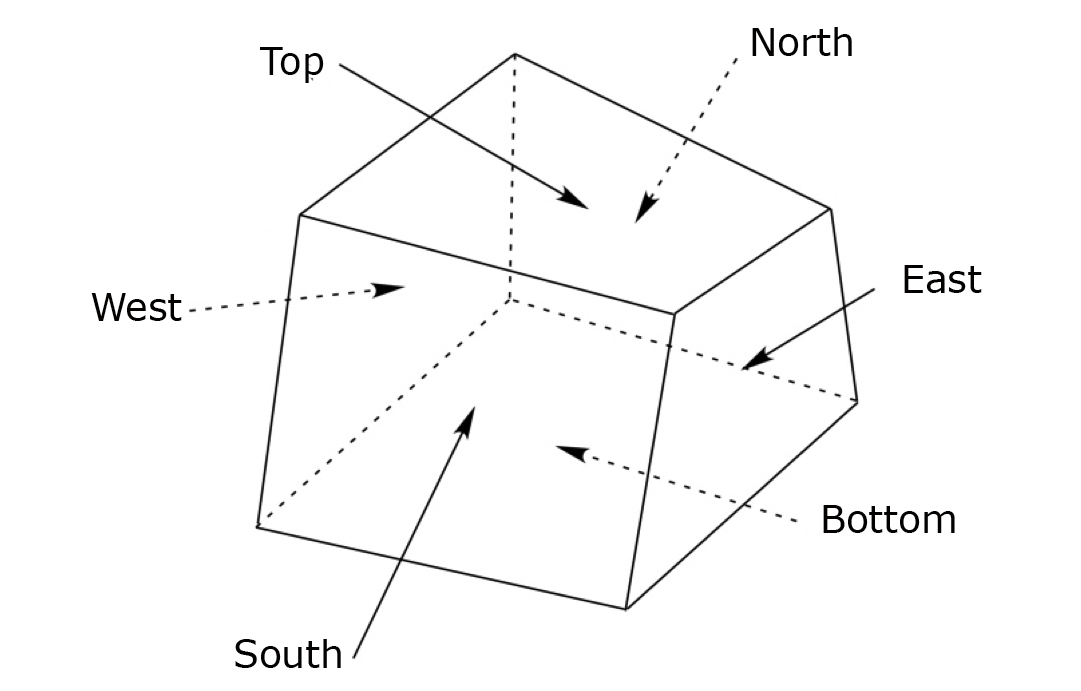Surface Flux Description (G)
Overview
Fluxes are computed in STOMP at the areal centroid of grid-cell surfaces. The Surface Flux Card allows the user to specify output of surface fluxes. All surface fluxes are reported to the surface file or user-defined files, and automatically include the flux rate and integral. Aqueous volumetric flux is a typical surface flux request and is computed as the product of the Darcy velocity and the surface area. Surface fluxes have both magnitude and direction. Surface fluxes are positive in sign when the flux is into the grid-cell volume. This definition of flux differs from that used for specifying boundary conditions. For example, for a West Surface (see Figure 1) positive fluxes are in the positive x-direction (with respect to the computational coordinate system), but for an East Surface (see Figure 1), positive fluxes are in the negative x-direction (with respect to the computational coordinate system). The advantage of defining the sign of surface fluxes in this fashion is that it allows the user to directly compute the total flux entering or exiting the grid volume from the surface fluxes. Table 1 shows the convention used for grid cell surfaces in STOMP. Individual grid-cell surfaces can be combined via the Surface Flux Card so that total flux rates and integrals are reported for the grouped surfaces. The Surface Flux Card even allows for all of the surfaces surrounding a grid-cell to be grouped into one surface.
Figure 1. Grid-cell Surface Naming
Table 2. Grid-Cell Surface Conventions with Respect to the Computational Coordinate System (CCS)
Grid-Cell Surface Name | Positive Surface Flux Direction | GCS Orientation | GCS Position | GCS Surface Normal |
|---|---|---|---|---|
| Bottom | Positive Z-Direction | X-Y Trending | Lower Surface | Negative Z-Direction |
| South | Positive Y-Direction | X-Z Trending | Lower Surface | Negative Y-Direction |
| West | Positive X-Direction | Y-Z Trending | Lower Surface | Negative X-Direction |
| East | Negative X-Direction | Y-Z Trending | Upper Surface | Positive X-Direction |
| North | Negative Y-Direction | X-Z Trending | Upper Surface | Positive Y-Direction |
| Top | Negative Z-Direction | X-Y Trending | Upper Surface | Positive Z-Direction |
Application Notes
This card allows the user to specify the output of fluxes of fluid mass, fluid volume, heat, component mass, solutes, and reactive species. A surface can be a single surface of a grid cell, or a collection of grid-cell surfaces. Collections of grid-cell surfaces are created defining a span of surfaces or by linking surfaces together. Output from the surface flux integration routines is written to the surface file and contains flux rate and integral data for each defined surface at every time step. The types of fluxes that can be tracked depend on the operational mode. To aid in the organization of surface flux data, surface fluxes can be output to multiple files. The default output file is named surface. All surface flux output files can be converted for plotting using the surfaceTo.pl perl script utility.

